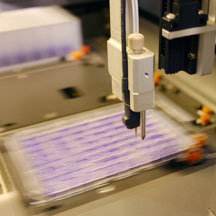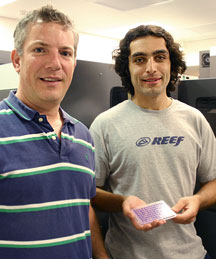

Structures on the Fast Track
By Mika Ono
Ian Wilson wants to solve biological structures—a lot of them, and fast. That's why he initiated a new robotic crystallization facility, which after almost two years of planning, negotiating, and building, is now officially ready to go.
"With robotic crystallization, you can do things faster, more reproducibly, and with much smaller volumes of protein," says Wilson, who is a professor at The Scripps Research Institute and a member of its Skaggs Institute for Chemical Biology. "This makes a huge difference."
The new system, located at 3040 Science Park Drive, arrived on Scripps Research's La Jolla campus in March and completed its final round of testing early this week. Wilson plans to harness the new system to examine a range of molecules, including those relating to the immune system, influenza, and human immunodeficiency virus (HIV).
A New Structure Every Three Working Days
This new machine is a boon to scientists because x-ray crystallography can be a tricky business.
X-ray crystallography is a technique that can solve structures to exquisitely high resolution. To make the technique work, scientists manipulate a protein or some other molecule so that a crystal forms. This crystal is then placed in front of a beam of x-rays, which diffract when they strike the atoms in the crystal. Based on the pattern of diffraction, scientists can reconstruct the shape of the original molecule.
The catch is that it can be extremely difficult to get a crystal to form. In the past, scientists have spent months trying to coax a protein to form crystals by varying dozens of conditions and combinations of conditions, such as temperature, ionic strength, protein concentration, buffer, and pH—time spent with no guarantee of success.
Robotic crystallography brings the technique to a new level. Instead of varying conditions one by one, scientists can run dozens of conditions at once to see if any work.
In fact, the new system at Scripps Research is so automated and integrated that scientists can put a sample of protein in at one end, and, if all goes well, some two weeks later pick up high quality crystals to solve the structure. The machine handles the dispensing, sealing, incubation, and imaging without any human intervention.
This robotic technology helps Wilson and his collaborators' ambitious goal to solve between 100 and 200 structures a year—about one every three working days. Not only will the integrated robotics system enable the team to run more samples, potentially more of these samples will be solved.
"A robot can run tests faster, so the protein doesn't degrade," notes Wilson. "This can lead to new results."
While we don't know exactly which structures will yield their secrets to the technique—several samples are run for every structure solved—Wilson has no doubts about the validity of the process. "We do know we will grow crystals and solve structures," he says. "There's no question about that."
Building Momentum
Momentum for the new robotic facility comes from two sources—a national protein structure initiative (PSI) of the National Institutes of Health (NIH), and the International AIDS Vaccine Initiative (IAVI), a global not-for-profit organization working to speed the search for a vaccine to prevent HIV infection and AIDS.
The Joint Center for Structural Genomics, a multi-institutional consortium headed by Wilson, began using robotic crystallization about six years ago as part of the first phase of the NIH protein structure initiative. The JCSG was formed at that time as one of nine centers receiving NIH funding to develop high-throughput methods—critical for increasing the numbers of structures determined per year and reducing the cost per structure. The JCSG draws on the talents of more than 70 researchers from Scripps Research; the Genomics Institute of the Novartis Research Foundation (GNF); the University of California, San Diego; the Stanford Synchroton Radiation Laboratory, a division of the Stanford Linear Accelerator Center at Stanford University; and the Burnham Institute.
In its role as a production center for the protein structure initiative, the JCSG developed a high-throughput structural platform providing rapid structure determination on a range of targets from bacteria to human. That includes challenging proteins, such as membrane proteins, eukaryotic proteins, and protein-protein complexes.
During the first phase of the grant, the JCSG group explored the use of robotic technology with resources at GNF and Syrrx, a San Diego company founded by Scripps Research Professors Peter Schultz and Raymond Stevens and later acquired by Takeda Pharmaceutical Company.
But when the second phase of the protein structure initiative began last year and the JCSG was selected as one of only four key centers for the next stage of the NIH effort, the team began to consider a dedicated robotic facility for its research.
Also in 2005, in collaboration with the Vaccine Research Center in Washington, DC, the Wilson lab solved a difficult structure relating to the effort to create an HIV vaccine. "We found that robotic crystallization was useful for difficult projects in gp120, which is the major surface antigen of HIV," says Wilson.
Because of its potential in this arena, the International AIDS Vaccine Initiative, which is headed by Scripps Research Professor Dennis Burton, threw its support behind the creation of a robotic facility on the Scripps Research campus.
With the backing of the International AIDS Vaccine Initiative, the JCSG, and The Scripps Research Institute, plans for the robotic crystallization facility were propelled forward.
Showpiece Design
The search for the right machine began.
A bidding process was conducted in conjunction with an outside consulting firm. After looking at the proposals, the Scripps Research team selected a Carlsbad company called RoboDesign (since acquired by Rigaku/MSC, Inc.) to provide the new system.
"Robodesign offered a fully integrated project," says Research Programmer Marc-André Elsliger of the Wilson lab, who manages the JCSG's Administrative Core. "We didn't have to buy components from different vendors and worry about having them work together."
The company collaborated with the researchers to redesign components for their needs. After many months of development, RoboDesign had produced what company personnel consider a model system, called CrystalMation. The machine, one of the largest of its kind, has storage capacity for 4,000 plates at up to six different temperatures as well as fully automated imaging, scheduling, and analysis software.
While the machine was being developed, the building at 3040 Science Park Drive was being prepared to house it.
"We installed vibration control, dust control, temperature control, humidity control, water control—and a lot of power," says Scripps Research Planning and Construction Project Manager Ron Jenkins. "We also made a special effort to make the robotic room bright and uplifting, since the machine will be used as a showpiece."
The 3040 building will also include offices, labs, and several conference rooms to facilitate collaboration within the JCSG, among different protein structure initiative centers across the country, and with other research groups. Once the remaining facilities are completed in August, Scripps Research Assistant Professor Scott Lesley, who heads the JCSG's Crystallomics Core, will be among those located in the building.
While robotics facility collaborations are already in the works with many campus groups, other collaborations with Scripps Research teams are in the process of coming together, for example with Professor James Paulson's Consortium for Functional Glycomics. Scripps Research investigators interested in the facility are encouraged to contact Wilson, wilson@scripps.edu, or Elsliger, elsliger@scripps.edu.
In the meantime, Wilson and his colleagues have prepared their first samples for the new machine and eagerly await the results.
For more information, see the web sites of the JCSG, the IAVI, and the Wilson lab.
Send comments to: mikaono[at]scripps.edu

"With robotic crystallization, you can do things faster, more reproducibly, and with much smaller volumes of protein," says Professor Ian Wilson. Photo by Biomedical Graphics.

The new robotic crystallization system, one of the largest of its kind, automates sample dispensing, sealing, incubation, and imaging. Photo by Kevin Fung.

Research Programmer Marc-André Elsliger (left), who manages the JCSG's
Administrative Core, and Research Assistant David Marciano check the new
facility. Photo by Kevin Fung.
